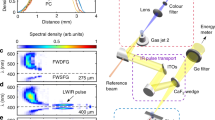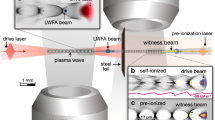Abstract
Plasma waves contribute to many fundamental phenomena, including astrophysics1, thermonuclear fusion2 and particle acceleration3. Such waves can develop in numerous ways, from classic Langmuir oscillations carried by electron thermal motion4, to the waves excited by an external force and travelling with a driver5. In plasma-based particle accelerators3,6, a strong laser or relativistic particle beam launches plasma waves with field amplitude that follows the driver strength up to the wavebreaking limit5,7, which is the maximum wave amplitude that a plasma can sustain. In this limit, plasma electrons gain sufficient energy from the wave to outrun it and to get trapped inside the wave bucket8. Theory and numerical simulations predict multi-dimensional wavebreaking, which is crucial in the electron self-injection process that determines the accelerator performances9,10. Here we present a real-time experimental visualization of the laser-driven nonlinear relativistic plasma waves by probing them with a femtosecond high-energy electron bunch from another laser-plasma accelerator coupled to the same laser system. This single-shot electron deflectometry allows us to characterize nonlinear plasma wakefield with femtosecond temporal and micrometre spatial resolutions revealing features of the plasma waves at the breaking point.
This is a preview of subscription content, access via your institution
Access options
Access Nature and 54 other Nature Portfolio journals
Get Nature+, our best-value online-access subscription
$29.99 / 30 days
cancel any time
Subscribe to this journal
Receive 12 print issues and online access
$209.00 per year
only $17.42 per issue
Buy this article
- Purchase on Springer Link
- Instant access to full article PDF
Prices may be subject to local taxes which are calculated during checkout



Similar content being viewed by others
Data availability
Data that support the findings of this study are available upon reasonable request from the corresponding authors. Source data are provided with this Paper.
Code availability
The codes that support the findings of this study are available from the corresponding authors upon reasonable request.
References
Ocker, S. K. et al. Persistent plasma waves in interstellar space detected by Voyager 1. Nat. Astron. 5, 761–765 (2021).
Betti, R. & Hurricane, O. Inertial-confinement fusion with lasers. Nat. Phys. 12, 435–448 (2016).
Tajima, T. & Dawson, J. M. Laser electron accelerator. Phys. Rev. Lett. 43, 267–270 (1979).
Tonks, L. & Langmuir, I. Oscillations in ionized gases. Phys. Rev. 33, 195–210 (1929).
Akhiezer, A. & Polovin, R. Theory of wave motion of an electron plasma. Sov. Phys. JETP 3, 696–705 (1956).
Chen, P., Dawson, J. M., Huff, R. W. & Katsouleas, T. Acceleration of electrons by the interaction of a bunched electron beam with a plasma. Phys. Rev. Lett. 54, 693–696 (1985).
Dawson, J. M. Nonlinear electron oscillations in a cold plasma. Phys. Rev. 113, 383–387 (1959).
Modena, A. et al. Electron acceleration from the breaking of relativistic plasma waves. Nature 377, 606–608 (1995).
Lu, W. et al. Generating multi-GeV electron bunches using single stage laser wakefield acceleration in a 3D nonlinear regime. Phys. Rev. Spec. Top. Accelerators Beams 10, 061301 (2007).
Kostyukov, I., Nerush, E., Pukhov, A. & Seredov, V. Electron self-injection in multidimensional relativistic-plasma wake fields. Phys. Rev. Lett. 103, 175003 (2009).
Malka, V. et al. Electron acceleration by a wake field forced by an intense ultrashort laser pulse. Science 298, 1596–1600 (2002).
Mangles, S. P. et al. Monoenergetic beams of relativistic electrons from intense laser–plasma interactions. Nature 431, 535–538 (2004).
Geddes, C. et al. High-quality electron beams from a laser wakefield accelerator using plasma-channel guiding. Nature 431, 538–541 (2004).
Faure, J. et al. A laser–plasma accelerator producing monoenergetic electron beams. Nature 431, 541–544 (2004).
Wang, W. et al. Free-electron lasing at 27 nanometres based on a laser wakefield accelerator. Nature 595, 516–520 (2021).
Blumenfeld, I. et al. Energy doubling of 42-GeV electrons in a metre-scale plasma wakefield accelerator. Nature 445, 741–744 (2007).
Litos, M. et al. High-efficiency acceleration of an electron beam in a plasma wakefield accelerator. Nature 515, 92–95 (2014).
Adli, E. et al. Acceleration of electrons in the plasma wakefield of a proton bunch. Nature 561, 363–367 (2018).
Gonsalves, A. et al. Petawatt laser guiding and electron beam acceleration to 8 GeV in a laser-heated capillary discharge waveguide. Phys. Rev. Lett. 122, 084801 (2019).
Rousse, A. et al. Production of a keV X-ray beam from synchrotron radiation in relativistic laser-plasma interaction. Phys. Rev. Lett. 93, 135005 (2004).
Kneip, S. et al. Bright spatially coherent synchrotron X-rays from a table-top source. Nat. Phys. 6, 980–983 (2010).
Cipiccia, S. et al. Gamma-rays from harmonically resonant betatron oscillations in a plasma wake. Nat. Phys. 7, 867–871 (2011).
Kozlova, M. et al. Hard X rays from laser-wakefield accelerators in density tailored plasmas. Phys. Rev. X 10, 011061 (2020).
Malka, V. et al. Principles and applications of compact laser–plasma accelerators. Nat. Phys. 4, 447–453 (2008).
Gorbunov, L. & Kirsanov, V. Excitation of plasma waves by an electromagnetic wave packet. Sov. Phys. JETP 66, 290–294 (1987).
Pukhov, A. & Meyer-ter Vehn, J. Laser wake field acceleration: the highly non-linear broken-wave regime. Appl. Phys. B 74, 355–361 (2002).
Lu, W., Huang, C., Zhou, M., Mori, W. & Katsouleas, T. Nonlinear theory for relativistic plasma wakefields in the blowout regime. Phys. Rev. Lett. 96, 165002 (2006).
Hafz, N. A. et al. Stable generation of GeV-class electron beams from self-guided laser–plasma channels. Nat. Photon. 2, 571–577 (2008).
Clayton, C. E. et al. Self-guided laser wakefield acceleration beyond 1 GeV using ionization-induced injection. Phys. Rev. Lett. 105, 105003 (2010).
Mangles, S. P. et al. Self-injection threshold in self-guided laser wakefield accelerators. Phys. Rev. Spec. Top. Accelerators Beams 15, 011302 (2012).
Corde, S. et al. Observation of longitudinal and transverse self-injections in laser-plasma accelerators. Nat. Commun. 4, 1501 (2013).
Downer, M., Zgadzaj, R., Debus, A., Schramm, U. & Kaluza, M. Diagnostics for plasma-based electron accelerators. Rev. Mod. Phys. 90, 035002 (2018).
Matlis, N. H. et al. Snapshots of laser wakefields. Nat. Phys. 2, 749–753 (2006).
Kaluza, M. et al. Measurement of magnetic-field structures in a laser-wakefield accelerator. Phys. Rev. Lett. 105, 115002 (2010).
Buck, A. et al. Real-time observation of laser-driven electron acceleration. Nat. Phys. 7, 543–548 (2011).
Chang, Y.-Y. et al. Faraday rotation study of plasma bubbles in GeV wakefield accelerators. Phys. Plasmas 28, 123105 (2021).
Sävert, A. et al. Direct observation of the injection dynamics of a laser wakefield accelerator using few-femtosecond shadowgraphy. Phys. Rev. Lett. 115, 055002 (2015).
Gilljohann, M. et al. Direct observation of plasma waves and dynamics induced by laser-accelerated electron beams. Phys. Rev. X 9, 011046 (2019).
Ding, H. et al. Nonlinear plasma wavelength scalings in a laser wakefield accelerator. Phys. Rev. E 101, 023209 (2020).
Zhang, C. et al. Capturing relativistic wakefield structures in plasmas using ultrashort high-energy electrons as a probe. Sci. Rep. 6, 29485 (2016).
Lundh, O. et al. Few femtosecond, few kiloampere electron bunch produced by a laser–plasma accelerator. Nat. Phys. 7, 219–222 (2011).
Zhang, C. et al. Temporal characterization of ultrashort linearly chirped electron bunches generated from a laser wakefield accelerator. Phys. Rev. Accelerators Beams 19, 062802 (2016).
Zhang, C. et al. Femtosecond probing of plasma wakefields and observation of the plasma wake reversal using a relativistic electron bunch. Phys. Rev. Lett. 119, 064801 (2017).
Kroupp, E. et al. Commissioning and first results from the new 2 × 100 TW laser at the WIS. Matter Radiat. Extremes 7, 044401 (2022).
Sun, G.-Z., Ott, E., Lee, Y. & Guzdar, P. Self-focusing of short intense pulses in plasmas. Phys. Fluids 30, 526–532 (1987).
Thomas, A. et al. Effect of laser-focusing conditions on propagation and monoenergetic electron production in laser-wakefield accelerators. Phys. Rev. Lett. 98, 095004 (2007).
Tsung, F., Ren, C., Silva, L., Mori, W. & Katsouleas, T. Generation of ultra-intense single-cycle laser pulses by using photon deceleration. Proc. Natl Acad. Sci. USA 99, 29–32 (2002).
Faure, J. et al. Observation of laser-pulse shortening in nonlinear plasma waves. Phys. Rev. Lett. 95, 205003 (2005).
Streeter, M. et al. Observation of laser power amplification in a self-injecting laser wakefield accelerator. Phys. Rev. Lett. 120, 254801 (2018).
Pak, A. et al. Injection and trapping of tunnel-ionized electrons into laser-produced wakes. Phys. Rev. Lett. 104, 025003 (2010).
McGuffey, C. et al. Ionization induced trapping in a laser wakefield accelerator. Phys. Rev. Lett. 104, 025004 (2010).
Schmid, K. et al. Density-transition based electron injector for laser driven wakefield accelerators. Phys. Rev. Spec. Top. Accel. Beams 13, 091301 (2010).
Buck, A. et al. Shock-front injector for high-quality laser-plasma acceleration. Phys. Rev. Lett. 110, 185006 (2013).
Thomas, A. G. R. Scalings for radiation from plasma bubbles. Phys. Plasmas 17, 056708 (2010).
Benedetti, C., Schroeder, C., Esarey, E., Rossi, F. & Leemans, W. Numerical investigation of electron self-injection in the nonlinear bubble regime. Phys. Plasmas 20, 103108 (2013).
Lu, W. et al. A nonlinear theory for multidimensional relativistic plasma wave wakefields. Phys. Plasmas 13, 056709 (2006).
Dalichaouch, T. N. et al. A multi-sheath model for highly nonlinear plasma wakefields. Phys. Plasmas 28, 063103 (2021).
Lehe, R., Kirchen, M., Andriyash, I. A., Godfrey, B. B. & Vay, J.-L. A spectral, quasi-cylindrical and dispersion-free particle-in-cell algorithm. Comput. Phys. Commun. 203, 66–82 (2016).
Acknowledgements
This work was supported by The Schwartz/Reisman Center for Intense Laser Physics, by a research grant from the Benoziyo Endowment Fund for the Advancement of Science, by the Israel Science Foundation, Minerva, Wolfson Foundation, the Schilling Foundation, R. Lapon, Dita and Yehuda Bronicki, and by the Helmholtz Association. The simulations were carried out at the Weizmann Institute’s EXAscale Cluster (WEXAC).
Author information
Authors and Affiliations
Contributions
Y.W. and V.M. conceived the idea and designed the set-up. Y.W., O.S. and S.T. carried out the experiment together, with support from S.S. and E.K. Y.W. analysed the data and performed the simulations with the help of I.A.A. Y.W., I.A.A. and V.M. wrote the paper. All authors discussed the results and commented on the manuscript. V.M. provided overall guidance to the project.
Corresponding author
Ethics declarations
Competing interests
The authors declare no competing interests.
Peer review
Peer review information
Nature Physics thanks Alexander Pukhov, Anthony Gonsalves and the other, anonymous, reviewer(s) for their contribution to the peer review of this work.
Additional information
Publisher’s note Springer Nature remains neutral with regard to jurisdictional claims in published maps and institutional affiliations.
Supplementary information
Supplementary Information
Supplementary Figs. 1–6, simulation details on the annular ring formation in the probe image.
Source data
Source Data Fig. 2
Plot data for Fig. 2f,g.
Source Data Fig. 3
Plot data for Fig.3b.
Rights and permissions
Springer Nature or its licensor holds exclusive rights to this article under a publishing agreement with the author(s) or other rightsholder(s); author self-archiving of the accepted manuscript version of this article is solely governed by the terms of such publishing agreement and applicable law.
About this article
Cite this article
Wan, Y., Seemann, O., Tata, S. et al. Direct observation of relativistic broken plasma waves. Nat. Phys. 18, 1186–1190 (2022). https://doi.org/10.1038/s41567-022-01717-6
Received:
Accepted:
Published:
Issue Date:
DOI: https://doi.org/10.1038/s41567-022-01717-6
This article is cited by
-
On the synergic approach toward the experimental realization of interesting fundamental science within the framework of relativistic flying mirror concept
Reviews of Modern Plasma Physics (2024)
-
Femtosecond electron microscopy of relativistic electron bunches
Light: Science & Applications (2023)
-
Refractive plasma optics for relativistic laser beams
Nature Communications (2023)
-
Single-shot electron radiography using a laser–plasma accelerator
Scientific Reports (2023)



